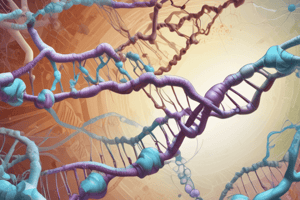Podcast
Questions and Answers
What is the primary role of messenger RNA (mRNA)?
What is the primary role of messenger RNA (mRNA)?
- To transfer amino acids
- To serve as a template for making proteins (correct)
- To provide structural support for ribosomes
- To initiate transcription
Transcription occurs in the cytoplasm of eukaryotes.
Transcription occurs in the cytoplasm of eukaryotes.
False (B)
What are the two main elements that position RNA polymerase during transcription in prokaryotes?
What are the two main elements that position RNA polymerase during transcription in prokaryotes?
The -10 element and the -35 element.
The process of creating a single-stranded RNA molecule from double-stranded DNA is called __________.
The process of creating a single-stranded RNA molecule from double-stranded DNA is called __________.
Match the types of RNA with their main functions:
Match the types of RNA with their main functions:
Which component is most abundant in total RNA?
Which component is most abundant in total RNA?
RNA polymerase requires transcription factors to initiate transcription in prokaryotes.
RNA polymerase requires transcription factors to initiate transcription in prokaryotes.
Where does transcription generally begin in a gene?
Where does transcription generally begin in a gene?
The __________ region is typically located about 25 bases upstream from the startpoint for RNA polymerase II.
The __________ region is typically located about 25 bases upstream from the startpoint for RNA polymerase II.
What percentage of total RNA does transfer RNA (tRNA) make up?
What percentage of total RNA does transfer RNA (tRNA) make up?
What is the start point of transcription designated as?
What is the start point of transcription designated as?
In which direction is the new RNA strand synthesized during the elongation step?
In which direction is the new RNA strand synthesized during the elongation step?
During the termination step, RNA polymerase disassembles from the DNA after reaching the termination site.
During the termination step, RNA polymerase disassembles from the DNA after reaching the termination site.
What is the completed RNA also known as after transcription?
What is the completed RNA also known as after transcription?
RNA polymerase reads the template strand in the __ direction during the elongation step.
RNA polymerase reads the template strand in the __ direction during the elongation step.
Match the stages of transcription with their descriptions:
Match the stages of transcription with their descriptions:
Which of the following is not involved in RNA processing?
Which of the following is not involved in RNA processing?
The RNA polymerase does not have any proofreading mechanism during transcription.
The RNA polymerase does not have any proofreading mechanism during transcription.
Why does RNA polymerase move along the DNA during transcription?
Why does RNA polymerase move along the DNA during transcription?
The process of adding a poly-A tail to the __ end of the RNA is part of RNA processing.
The process of adding a poly-A tail to the __ end of the RNA is part of RNA processing.
What happens to the primary RNA transcript after transcription in eukaryotic cells?
What happens to the primary RNA transcript after transcription in eukaryotic cells?
What is the main function of the cap and poly-A tail added to mRNA?
What is the main function of the cap and poly-A tail added to mRNA?
Introns are sequences that code for proteins.
Introns are sequences that code for proteins.
What is the role of the spliceosome in RNA processing?
What is the role of the spliceosome in RNA processing?
A ______ is the sequence of three nucleotides on mRNA that codes for a specific amino acid.
A ______ is the sequence of three nucleotides on mRNA that codes for a specific amino acid.
Match the following components with their functions in translation:
Match the following components with their functions in translation:
Which codon is recognized as the start codon in mRNA?
Which codon is recognized as the start codon in mRNA?
Translation occurs in the nucleus of eukaryotic cells.
Translation occurs in the nucleus of eukaryotic cells.
What is the significance of the wobble base in codons?
What is the significance of the wobble base in codons?
In eukaryotes, transcription and translation are ______ from each other.
In eukaryotes, transcription and translation are ______ from each other.
What happens during the termination phase of translation?
What happens during the termination phase of translation?
Flashcards
Central Dogma of Biology
Central Dogma of Biology
The process by which genetic information flows from DNA to RNA to proteins.
Transcription
Transcription
The process of copying DNA into RNA.
RNA Polymerase
RNA Polymerase
The enzyme that reads DNA and synthesizes RNA.
Promoter
Promoter
Signup and view all the flashcards
-10 Sequence
-10 Sequence
Signup and view all the flashcards
-35 Sequence
-35 Sequence
Signup and view all the flashcards
Messenger RNA (mRNA)
Messenger RNA (mRNA)
Signup and view all the flashcards
Transfer RNA (tRNA)
Transfer RNA (tRNA)
Signup and view all the flashcards
Ribosomal RNA (rRNA)
Ribosomal RNA (rRNA)
Signup and view all the flashcards
Transcription Factor
Transcription Factor
Signup and view all the flashcards
Transcription (Elongation)
Transcription (Elongation)
Signup and view all the flashcards
Template Strand (Transcription)
Template Strand (Transcription)
Signup and view all the flashcards
Promoter Region
Promoter Region
Signup and view all the flashcards
Termination Sequence
Termination Sequence
Signup and view all the flashcards
Primary RNA Transcript (pre-RNA)
Primary RNA Transcript (pre-RNA)
Signup and view all the flashcards
RNA Processing
RNA Processing
Signup and view all the flashcards
5' Cap (RNA Processing)
5' Cap (RNA Processing)
Signup and view all the flashcards
Poly-A Tail (RNA Processing)
Poly-A Tail (RNA Processing)
Signup and view all the flashcards
Intron Splicing
Intron Splicing
Signup and view all the flashcards
Spliceosome
Spliceosome
Signup and view all the flashcards
5' Cap
5' Cap
Signup and view all the flashcards
Poly-A tail
Poly-A tail
Signup and view all the flashcards
Translation
Translation
Signup and view all the flashcards
Ribosome
Ribosome
Signup and view all the flashcards
Initiation
Initiation
Signup and view all the flashcards
Elongation
Elongation
Signup and view all the flashcards
Termination
Termination
Signup and view all the flashcards
Study Notes
Gene Expression & Protein Synthesis Overview
- Gene expression is the process by which information from a gene is used in the synthesis of a functional gene product, typically a protein.
- The central dogma of biology describes the flow of genetic information from DNA to RNA to proteins.
The Central Dogma
- Genetic information flows from DNA to RNA to proteins.
- Replication is the process of creating a copy of DNA
- Transcription is the process of making RNA from a DNA template.
- Occurs in the nucleus of eukaryotes
- Occurs in the cytoplasm of prokaryotes
- Translation is the process of using the information in RNA to create a protein. Occurs in the cytoplasm.
Types of RNA
- Messenger RNA (mRNA): Used as a template to make proteins; 3-5% of total RNA
- Transfer RNA (tRNA): Brings amino acids to mRNA and ribosomes; ~15% of total RNA
- Ribosomal RNA (rRNA): Makes up ribosomes; ~80% of total RNA
Transcription Details
- A portion of double-stranded DNA is transcribed into a single-stranded RNA molecule.
- Initiation: RNA polymerase binds to the promoter region on the gene.
- Elongation: RNA polymerase moves along the DNA template strand, synthesizing the RNA molecule.
- Termination: RNA polymerase reaches a termination sequence and stops, releasing the newly made RNA molecule.
Eukaryotic Promoter
- Typically found near the beginning of a gene.
- Contains a TATA box, a short DNA sequence (~25 bases upstream) that is critical for RNA polymerase binding.
Prokaryotic Promoter
- Contains a -10 and -35 sequence (located 10 and 35 nucleotides upstream to the startpoint) that help RNA polymerase bind to the DNA.
- The two elements position the RNA polymerase and determine the direction it operates.
Transcription Elongation
- RNA polymerase synthesizes RNA in a 5' to 3' direction.
- The template strand is read in the 3' to 5' direction.
- RNA polymerase untwists a portion of DNA double helix.
- The polymerase has a proofreading mechanism.
Termination Step
- End point of transcription where RNA polymerase disassembles from DNA.
- RNA typically called primary RNA transcript before processing
Post-Transcription Processing (Eukaryotes)
- Addition of a cap to the 5' end of RNA
- Addition of a poly-A tail to the 3' end of RNA
- Removal of introns (non-coding regions) and joining of exons (coding regions).
Introns and Exons
- Introns: Non-coding sequences removed during RNA processing.
- Exons: Coding sequences that make up the final mRNA.
Intron Splicing
- Introns are removed by spliceosomes while the RNA is still in the nucleus.
- Spliceosome is a complex of small nuclear RNAs and proteins.
Translation
- The process of "decoding" mRNA and assembling a protein.
- Major players: mRNA, tRNA, ribosomes, amino acids.
- Four phases: activation, initiation, elongation, termination
Messenger RNA (mRNA)
- Single-stranded RNA molecule complementary to a DNA template.
- Carries genetic instructions from DNA to cytoplasm.
- mRNA is read in codons (3 nucleotides each) that specify amino acids.
Genetic Code
-
Almost universal; used by both prokaryotes and eukaryotes.
-
64 codons, but code for 20 amino acids.
-
Degenerate means that more than one codon codes for most amino acids.
-
Wobble base allows for some flexibility in mRNA base pairings.
-
AUG (methionine) is the start codon.
-
UAA, UAG, and UGA are stop codons.
Ribosomes
- Protein factories of cells.
- Made of two subunits: large and small.
- Three sites: A site (aminoacyl-tRNA), P site (peptidyl-tRNA), and E site (exit site).
Translation Initiation
- mRNA, tRNA carrying methionine (initiator tRNA), and small ribosomal subunit come together.
- The complex forms at the 5' end of mRNA (ribosome binding site)
- The Large subunit of the ribosome finishes the initiation complex using GTP.
Translation Elongation
- Incoming tRNA with amino acid binds to A site.
- Polypeptide chain is moved from P site to new amino acid at the A site.
- Empty tRNA moves to the E site then exits.
Translation Termination
- Stop codon recognized by a release factor.
- Polypeptide chain is cleaved.
- Ribosomal subunits and mRNA dissociate.
Coupled Transcription and Translation (Prokaryotes)
- Transcription and translation occur simultaneously in bacteria.
- Ribosomes attach to mRNA as it's being synthesized.
Monocistronic vs. Polycistronic mRNA
- Monocistronic: One type of protein from a single mRNA molecule (eukaryotes)
- Polycistronic: Multiple protein types from a single mRNA molecule (prokaryotes)
Transfer RNA (tRNA)
- Has an anticodon that pairs with a codon on mRNA.
- Carries specific amino acids to the ribosome.
Studying That Suits You
Use AI to generate personalized quizzes and flashcards to suit your learning preferences.
Related Documents
Description
Explore the fundamental processes of gene expression and protein synthesis in this informative quiz. Understand the central dogma of biology, transcription, and translation, along with the different types of RNA involved in these processes. Test your knowledge and deepen your understanding of molecular biology.




